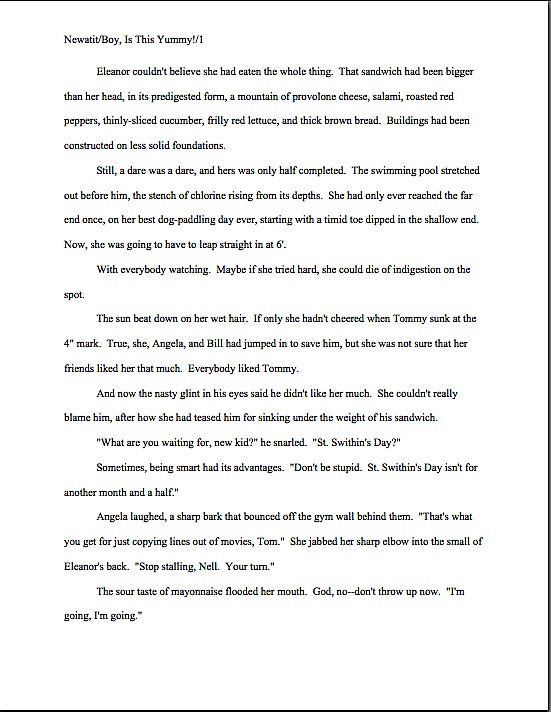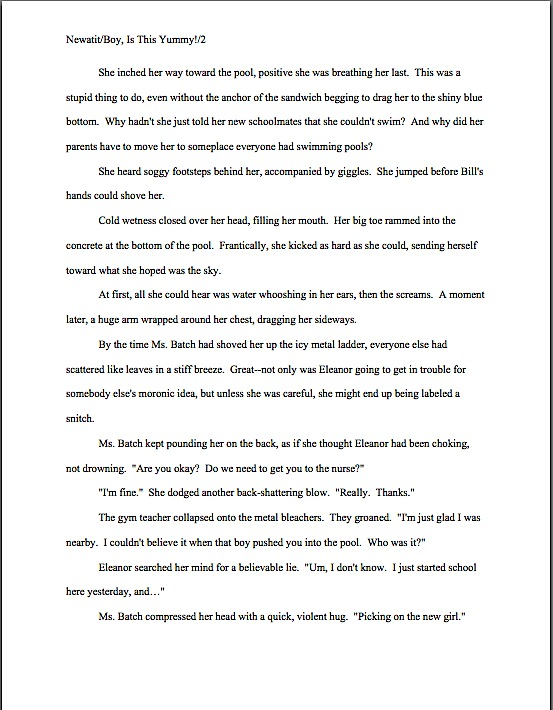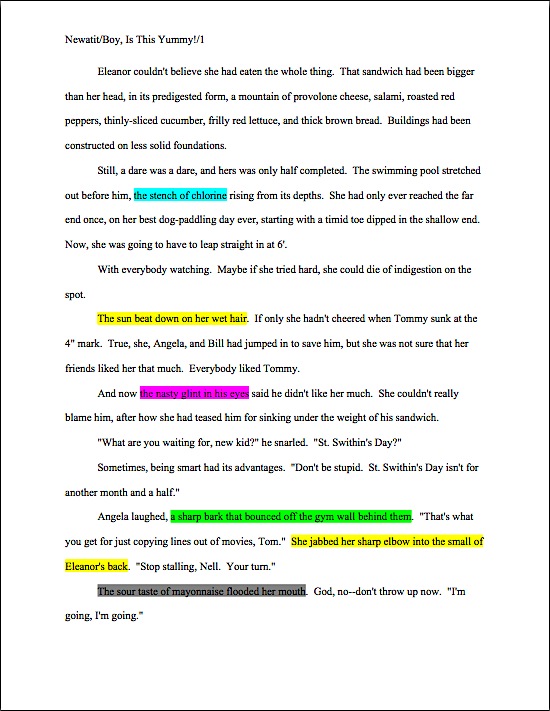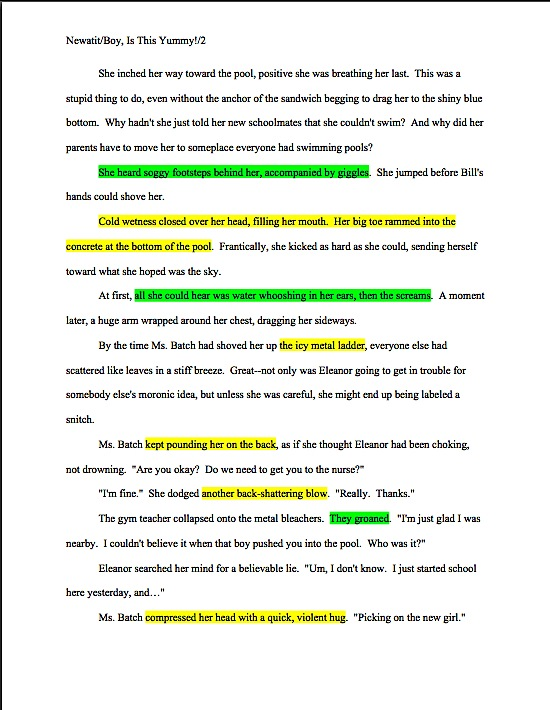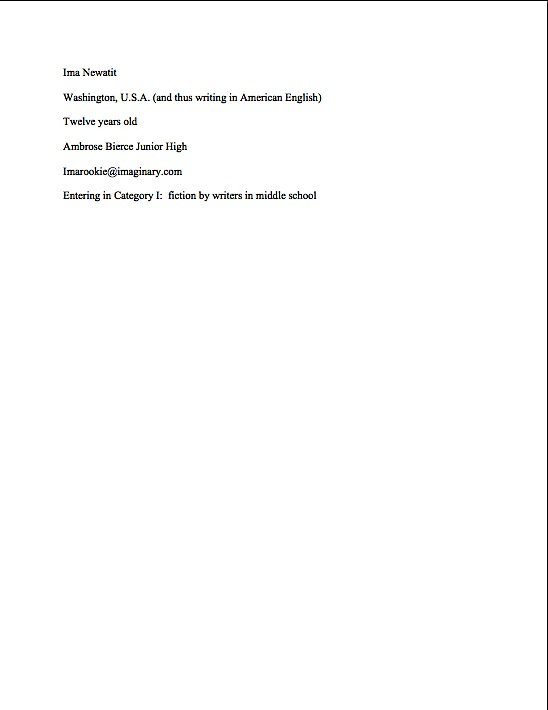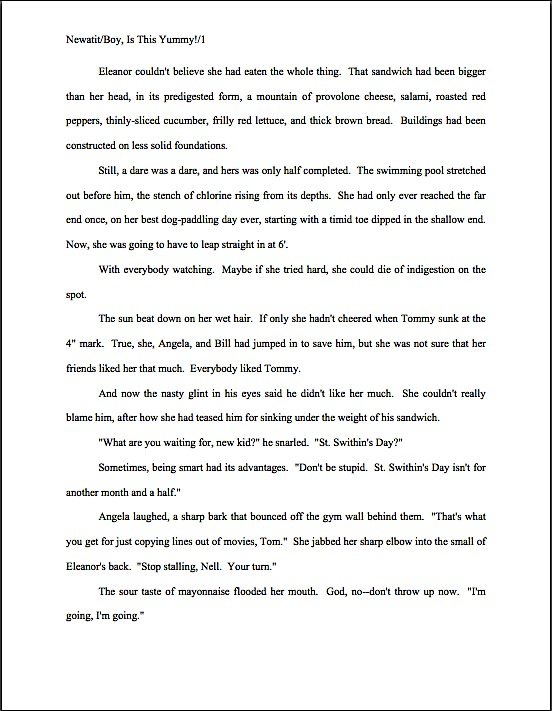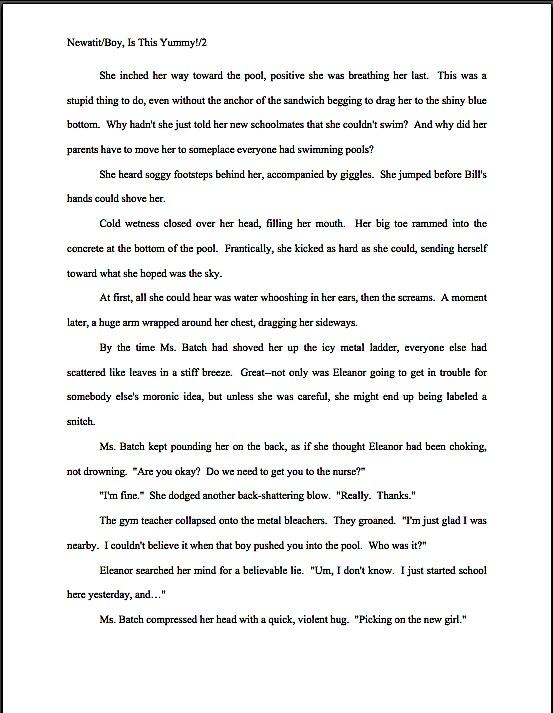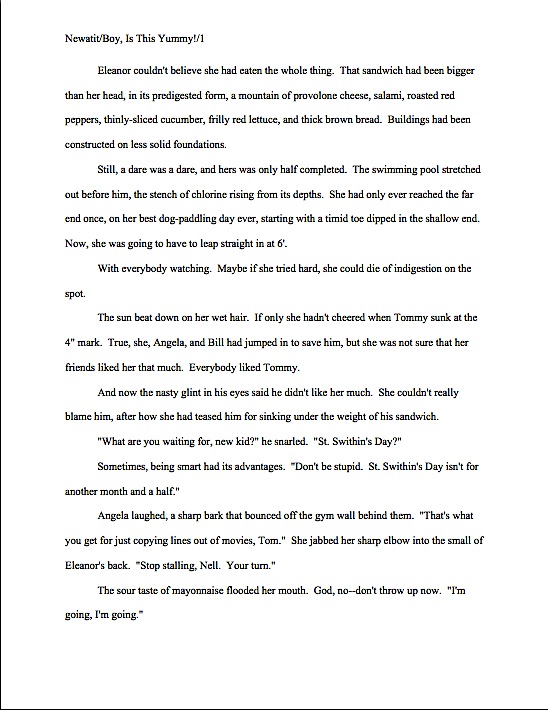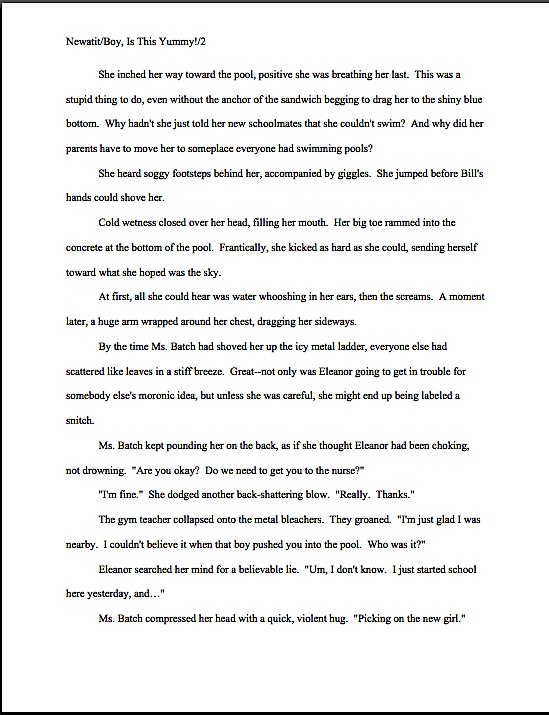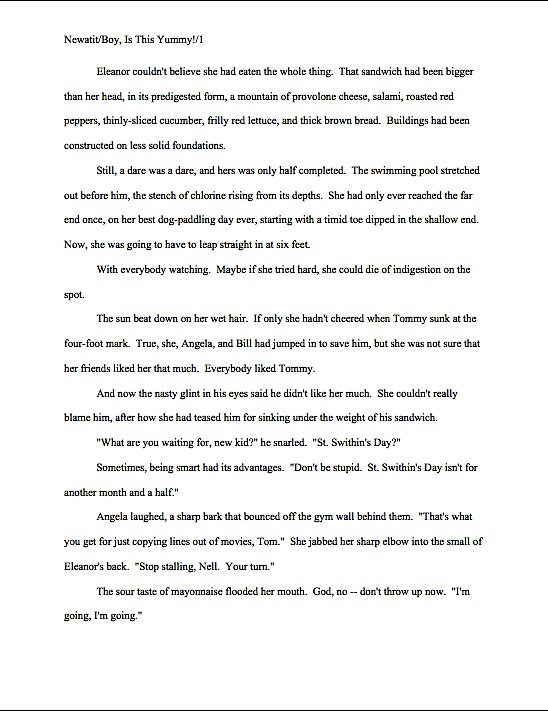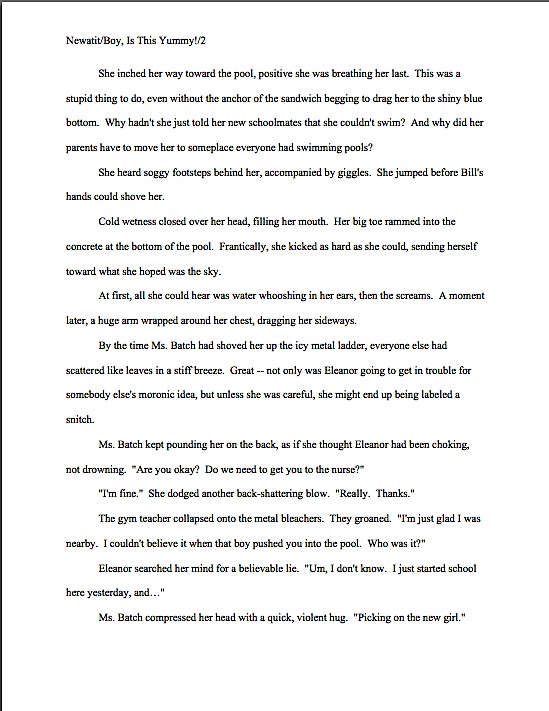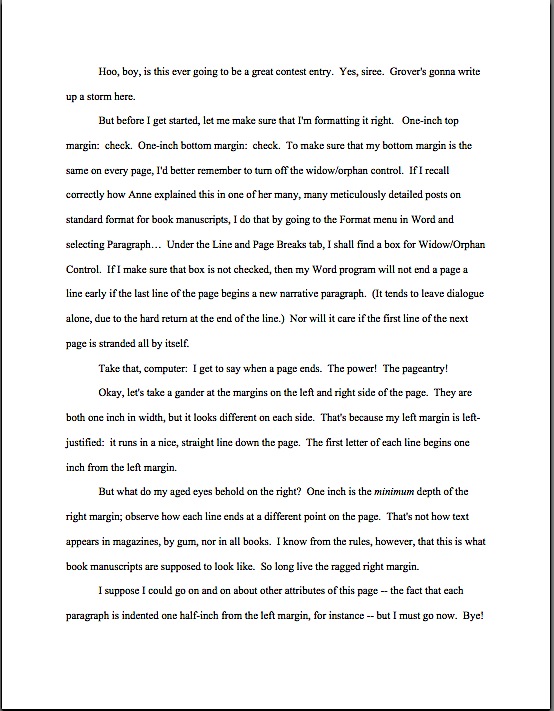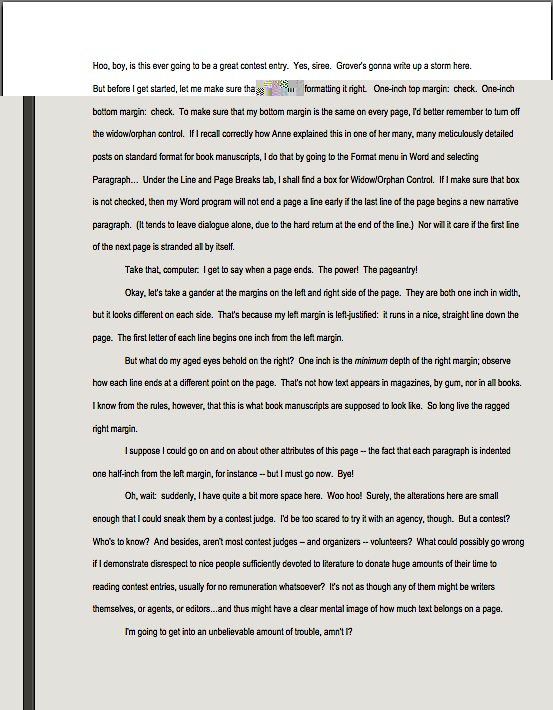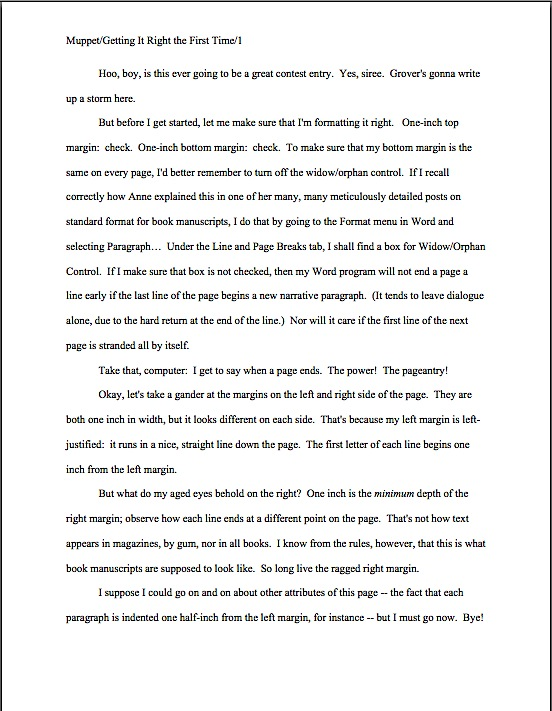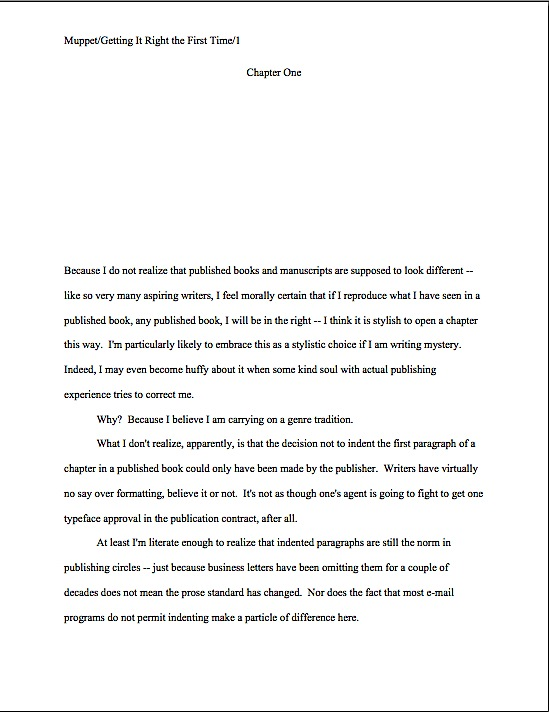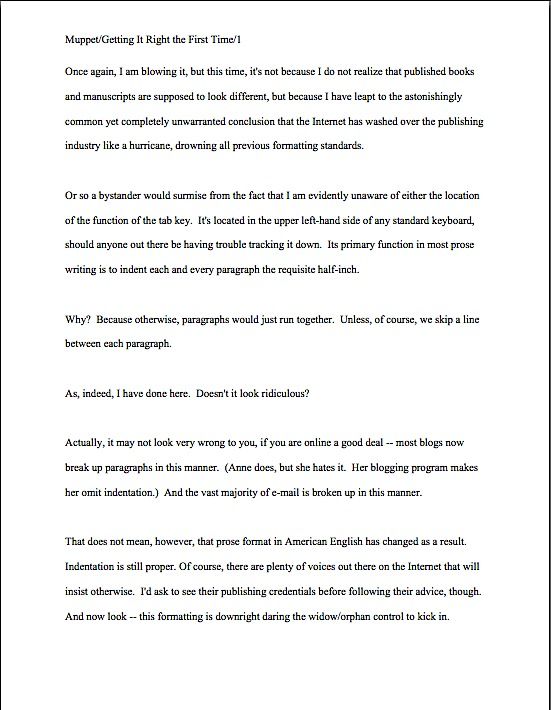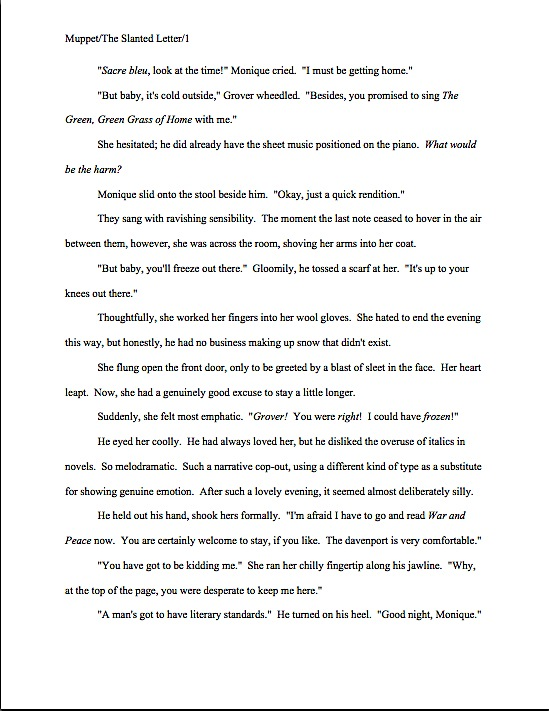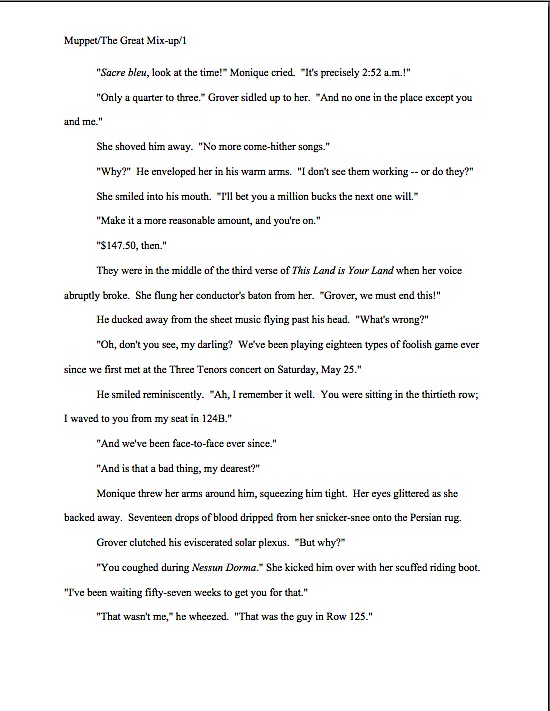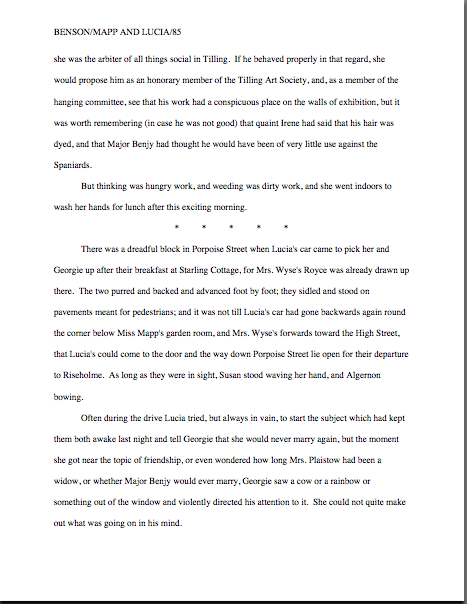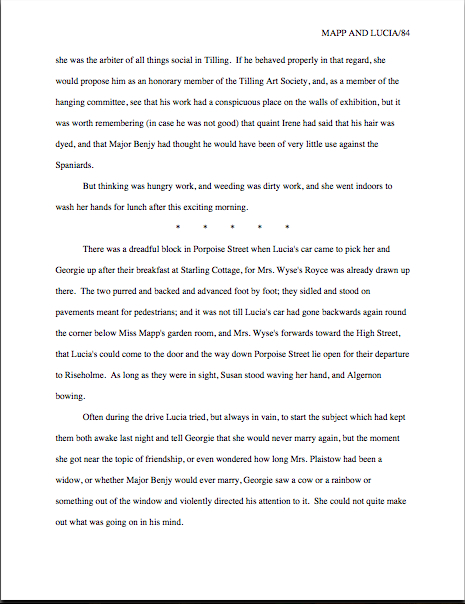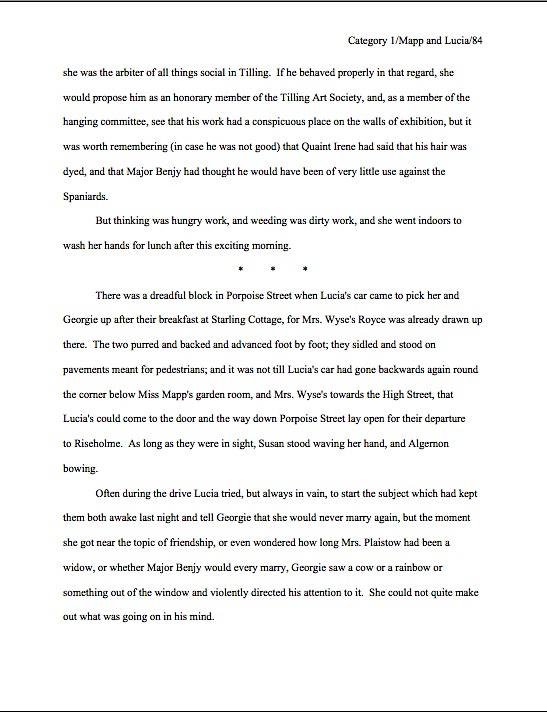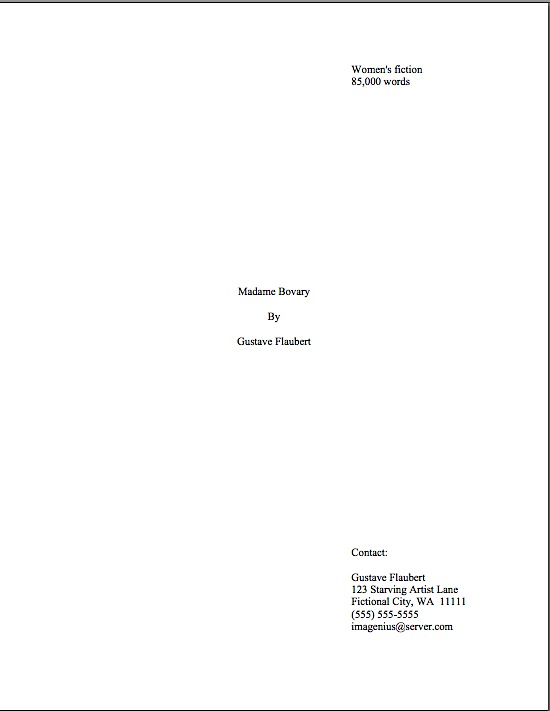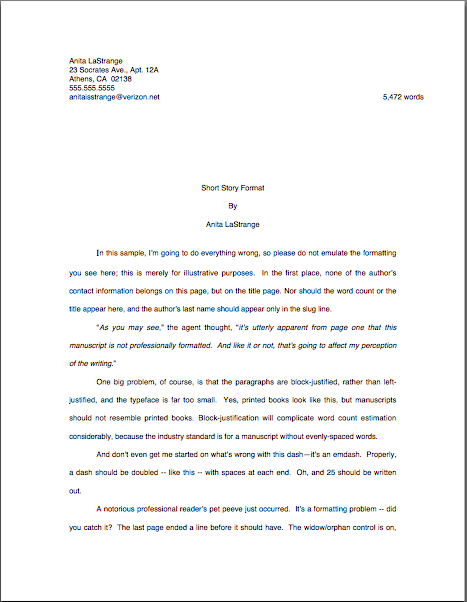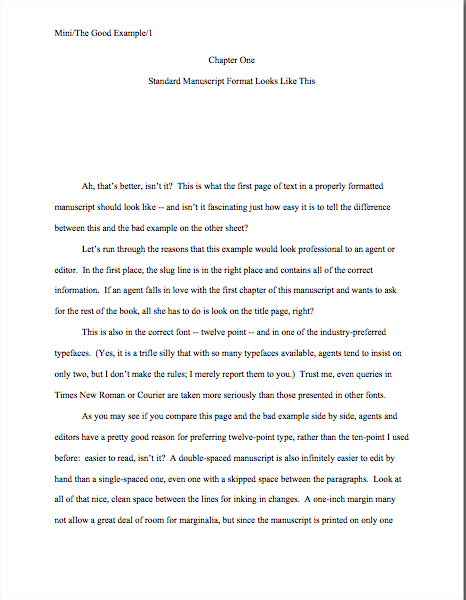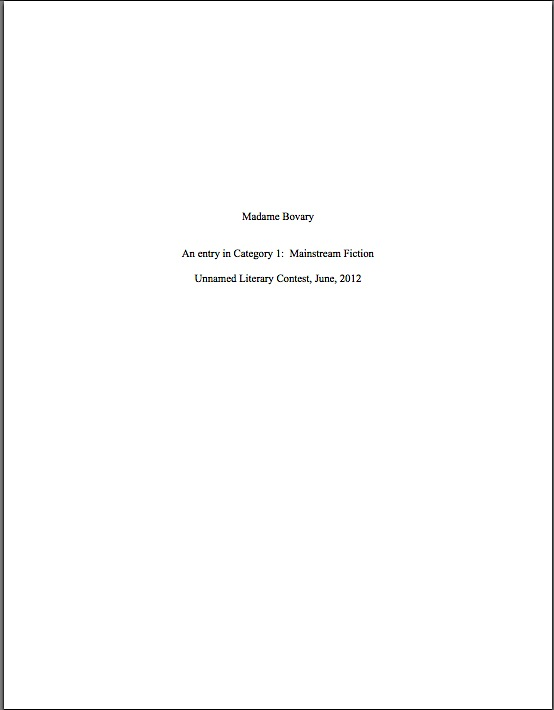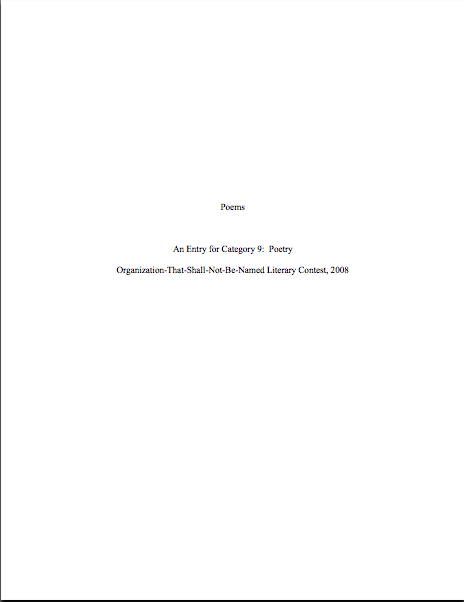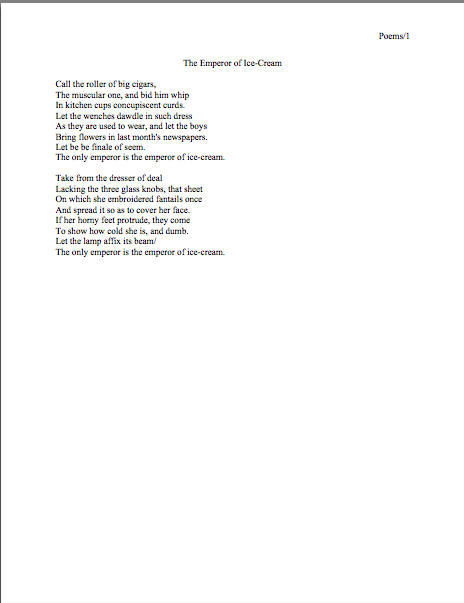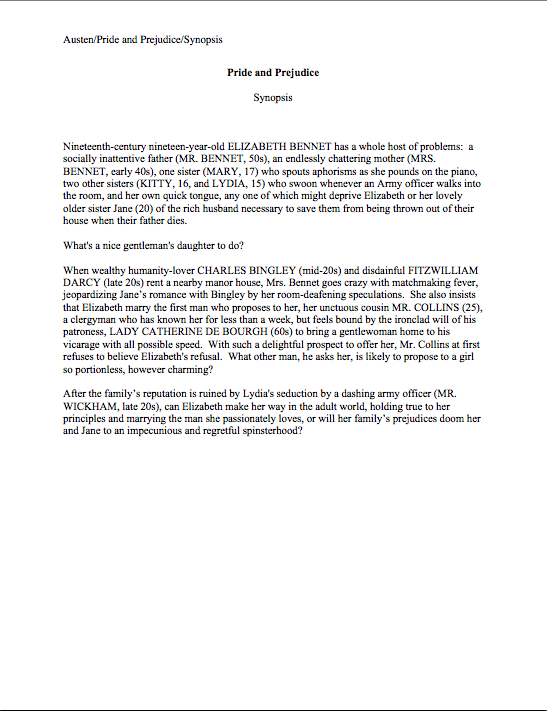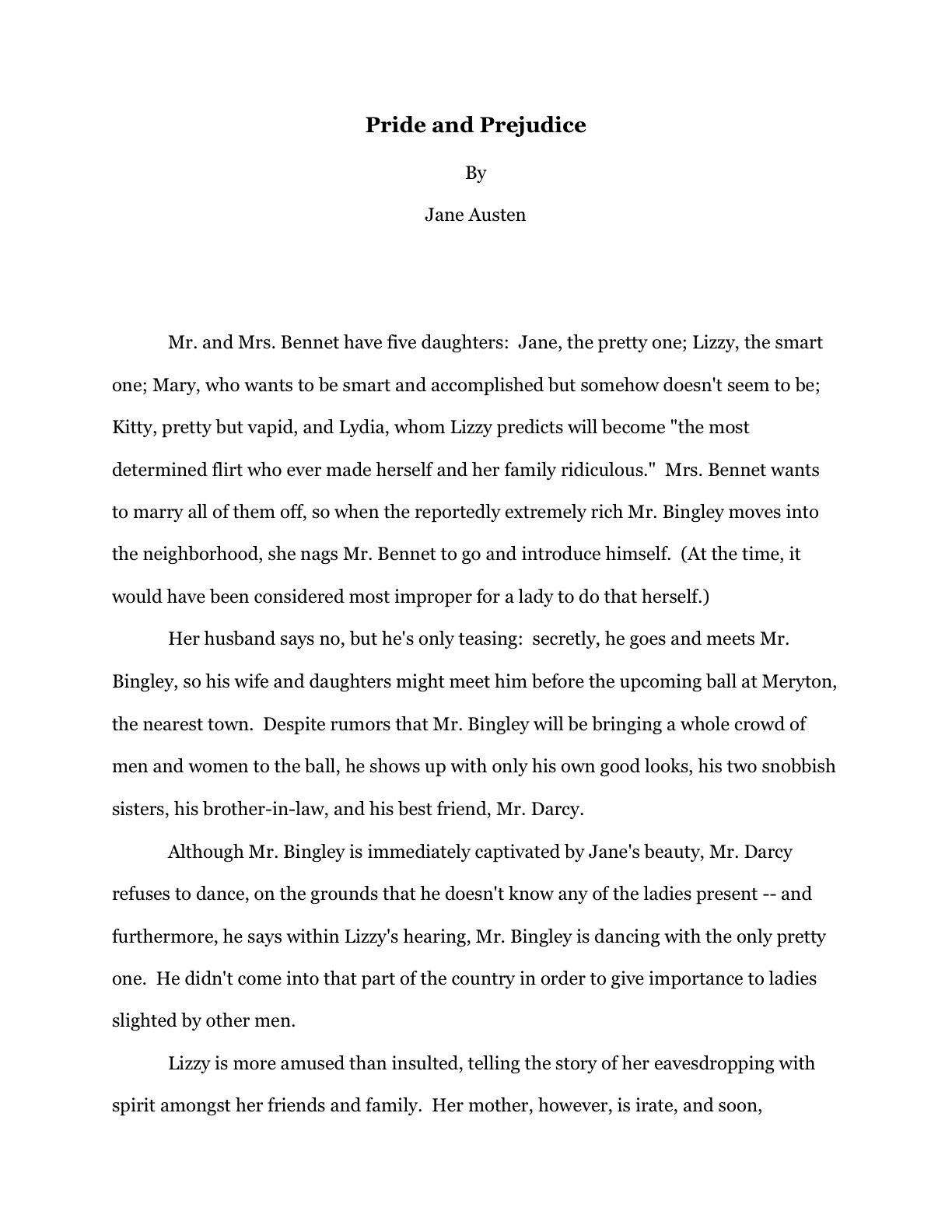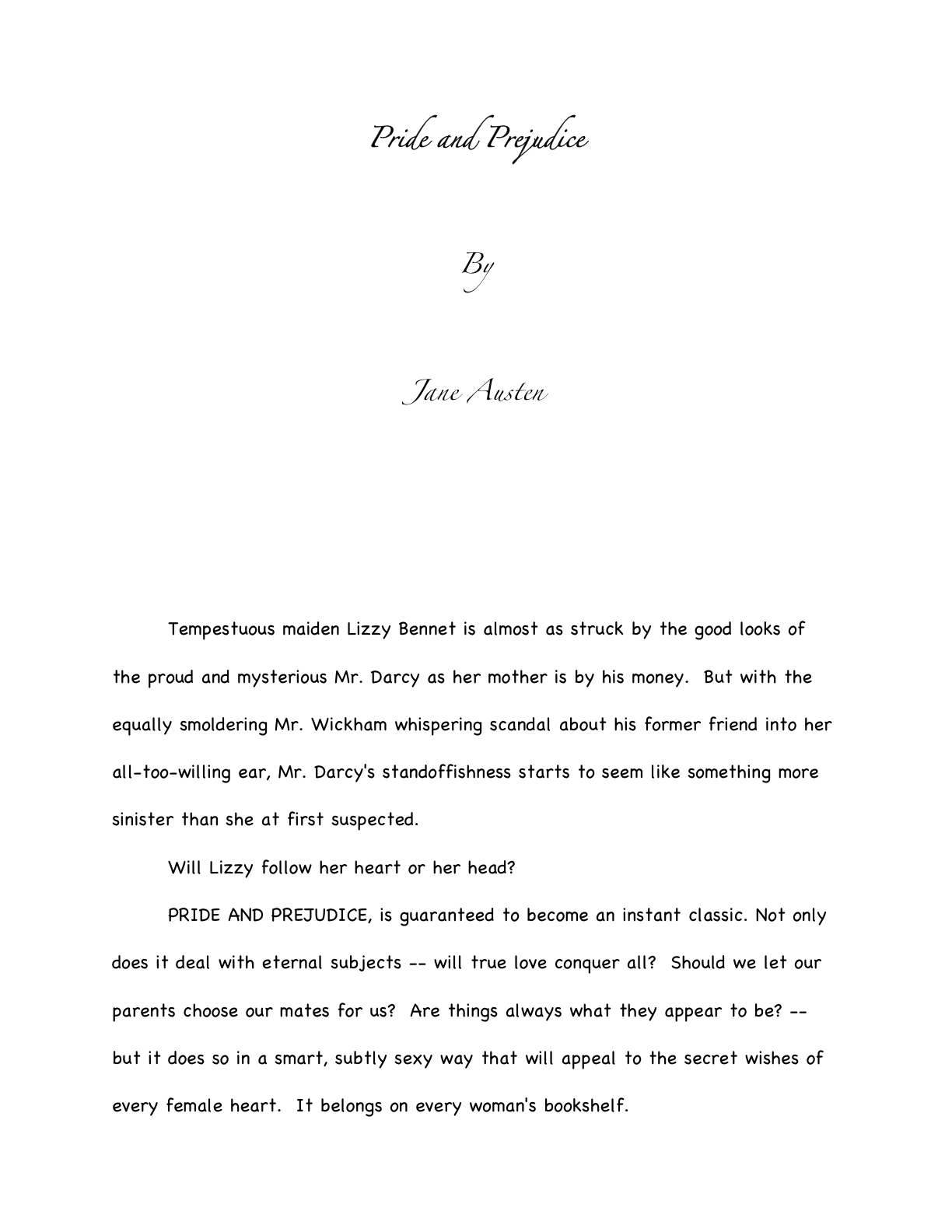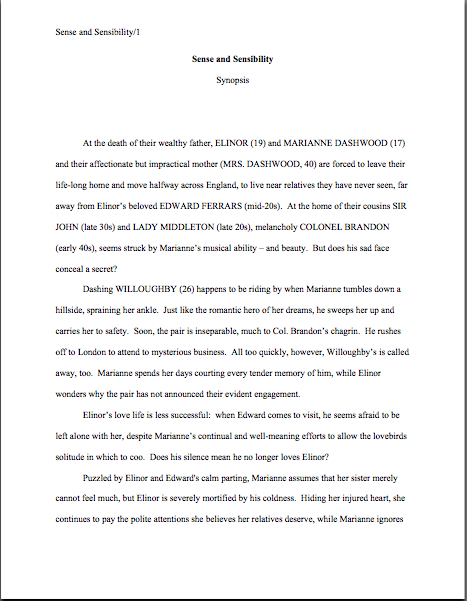As I hope every young writer within the reach of my keyboard is aware, I am now and have always been deeply committed to making age no barrier to membership in the Author! Author! community. I encourage questions and comments from writers just starting out; I try to keep the voice and vocabulary here at an extremely democratic reading level; I don’t allow profanity, even in the comments, so that filter programs at libraries or parental controls won’t block readers’ access. Heck, I once wrote a three-week series on how publishing does and doesn’t work in response to an extremely intelligent question from an 13-year-old.
He’d just completed his first novel and wasn’t sure what to do with it.
I do all of this, among other reasons, because in my opinion, there’s not enough good, solid discussion of writing for the under-18 crowd. Much of what is there strikes me as, well, a trifle condescending. And despite the fact that the fine print on the back of my adult card dictates that I should believe that youthful pursuers of my chosen profession could not possibly understand how it works, I can’t think that vague advice that would have insulted my intelligence in middle or high school would be a boon for writers in middle or high school now.
Call me zany, but I’m inclined to think that a smart, sensitive, creative person is a smart, sensitive, creative person at any age. I’m also inclined to think that it’s much, much harder for young writers to rack up the types of writing credentials that impress agents than it is for adults.
That massive groan you just heard was every aspiring writer in the continental United States writhing with frustration. It’s not easy for them, either. But let’s face it, there just are not a lot of contests out there for young writers that are not academically-oriented.
Which is why this year, instead of sponsoring only one Author! Author! Awards for Expressive Excellence competition, I’m offering two: one aimed at adult writers writing for the adult market and one for writers currently in middle school and high school, as well as those writing for readers in those age groups. Thus was the Make Us Want to Eat It Literary Competition of 2012 born, to create what we here at Author! Author! like to call Eye-Catching Query Letter Candy, writing credentials that will make your query letter stand out from the crowd.
I could have just felt good about that and gone home, of course. But having talked to a lot of young writers over the years, I have learned that one of the most common reasons that they don’t enter the few contests out there is that they’re afraid they are not going to put the entry together right.
At the risk of having my adult card revoked, allow me to let you in on a little secret: adult aspiring writers harbor that fear, too. In fact, they’re a bit more likely to be afraid of what a contest judge or agent will say; if they have been trying to get published for a while, they have probably been rejected quite a bit. And while anyone currently working within the publishing industry could tell them — and you — that getting rejected is a perfectly normal experience for writers that later end up selling their books to perfectly reputable publishers, it still hurts to hear no.
So many aspiring writers of all ages just give up, believing — not always correctly — that their work got rejected because their writing wasn’t good enough. Or because the market just wasn’t buying books like theirs. Or due to some deep hatred the staff at the agency of their dreams feels toward innovative prose stylings.
In practice, though, many, if not most, rejections do not stem from any of these sources — or, indeed, have much to do with what a writer would consider quality of writing. Queries and manuscripts get rejected all the time for purely technical reasons. Misspellings, for instance, or grammar problems. Lack of clarity. Overuse of clich?s. Not punctuating dialogue correctly. Not having been sent to an agent that represents that type of book.
Or — and this is one of the most common rejection triggers of all — not presenting the writing professionally.
Actually, I think younger writers have an easier time understanding technical rejections than those of us who have been kicking around the world longer typically do. Students are constantly running up against seemingly arbitrary rules and snap judgments. It may not be fair, but on the whole, smart kids learn to regard silly regulations and stereotyping philosophically. They’re just a part of going to school.
They’re just a part of holding a job, too, but writers often forget that professional writing is in fact a profession, with rules and standards just like any other. All too often, aspiring writers fall into the trap of believing that the publishing industry in general and agencies in particular are non-profit enterprises, selflessly devoted to the promotion of literature. So when an agent responds to a well-written manuscript like the businessperson she is, saying that she does not think she can sell it in the current literary market, aspiring writers often react with horror.
Or by giving up. Or by assuming that all agencies and publishing houses are uninterested in previously-unpublished writers. Or all of the above.
The fact is, though, that good writing by unknown writers gets published all the time. Previously-unpublished writers land agents literally every day. But I’m not going to lie to you: among the other factors that separate these writers’ manuscripts from, well, everybody else’s is that they are spelled correctly, grammatically sound, clearly written, free of clich?s, contain properly punctuated dialogue, and have been submitted to an agent that represents that type of book.
Oh, and they’re virtually always formatted correctly. In publishing circles, having taken the time to learn how book manuscripts are supposed to look is considered a sign of seriousness in a writer.
Which is why, in case you had been wondering, I spend so much time here on the blog talking about — wait for it — spelling, grammar, clarity, clich? avoidance, dialogue, and book category. And perhaps my favorite topic of all, standard format for book manuscripts. (Which, contrary to popular online opinion, is not identical to either what a published book looks like or proper format for short stories and articles.) I want my readers’ writing to be taken seriously.
In order to encourage learning the skills that will help them be taken seriously, I both explain the rules of standard format frequently and at great length here (with visual examples!) and require entrants in Author! Author! contests to format their entries correctly. Why, just the other day, I wrote aimed at helping entrants in the adult contest adhere to the rules of standard format. It’s not enough, I think, merely to provide writers with the opportunity to pick up some ECQLC; I want their manuscripts to be able to wow everybody’s favorite agency screener, Millicent. Like most of us that read manuscripts for a living, she’s distracted by improper formatting.
Which is a much better way to think of having to learn the rules of putting a manuscript together than to dismiss them as unimportant or ridiculous: not presenting your pages properly will make Millicent concentrate on something other than your good writing. She might not reject a submission or disqualify a contest entry on that basis alone, but it will almost certainly — chant it with me now, those of you who have been paying attention — take it less seriously.
Do I spot some raised hands out there? “But Anne,” those of you brand-new to the writing world will protest, “how do I get started? I’m more than willing to learn, but I’m frightened that Millicent won’t treat my early attempts with scorn. Why isn’t there a less high-stakes way I can try out my new presentation skills than sending my manuscript to an agency?”
Ah, but there is, bright rookies. You can enter a writing contest for practice.
Less intimidating than risking rejection, is it not? To make it even less scary, tell you what I’m going to do: for the rest of today’s post, I’m going to walk you through every syllable of the rules for Make Us Want to Eat It Literary Competition, giving you visual examples of how to apply those guidelines to your contest entry. And if you have questions, please ask them — I honestly do want to render the learning process as easy for you as possible.
Just remember to thank me on the Acknowledgements page of your first published book, okay?
Everybody ready? Okay, here goes. The contest’s rulesare in boldface; my explanations and helpful hints are in regular text.
The Make Us Want to Eat It Literary Competition of 2012
As I mentioned when I announced the previous contest for adult writing, although people experience life via all of their senses — sight, sound, taste, smell, touch — many, many of the manuscripts those of us who read them for a living see on a daily basis seem to assume that characters can only see and hear. Or that readers expect to know nothing about a character’s sensations except what an actor might be able to convey to us if we saw him playing that character on T.V.
But you’re a better writer than that, aren’t you? And you’re certainly a better reader.
This opening bit might not seem as though it’s important, but often, writing contest organizers will tell entrants up front what they want to see in a winning entry. It’s a good idea, then, not just to zoom in on the rules. It’s an even better idea to come back after you have finished writing your entry and re-read how the contest is presented, to make sure that what you are planning to send matches what the organizers are seeking.
This contest’s opening paragraphs will show you why: this says point-blank that the judges will be looking for entries that use all of the human senses in their descriptions. That means, in practice, that no matter how good the writing may be in the scene you were planning to enter, it’s unlikely to win unless the main character or the narration experiences what’s going on through many different sense organs — eyes, ears, nose, mouth, skin.
That’s the goal of the contest. Let’s move on to see if the contest’s organizers have told us how they want us to achieve that goal.
Because I’m pretty confident that my readers are good at writing about what it’s like to be alive, I’m calling for young writers and adults that write for young readers to enter short scenes — anywhere from 2 to 8 pages in length — that present food in a manner that incorporates more than two senses.
Here’s the catch: the scene can’t take place in a kitchen — or at a dining table.
Why? Because I’d love to see you exercise your creativity, that’s why. That’s my idea of a proper reader-oriented spectator sport.
Ah, now we know what the entry will need to be: a 2-8 page scene about food, set somewhere other than a kitchen or table. Since it would be really, really easy to spend your entire writing time just coming up with new material for literary contests, the first thing a savvy writer should do with this kind of information is ask: have I already written a scene that might meet this description?
If the answer is no, that’s fine; this is a short enough page limit that you could write something fresh before the deadline (which, although we haven’t yet gotten to it in the rules, is September 30th). But your next question should be: do I have enough time to write a scene that I like before the entry is due?
Please consider this question carefully; it’s more important than most contest entrants realize. Having been a very good English student, I’m perfectly aware that it is in fact possible to toss off something good enough at the last minute — oh, as if you’ve never done that with a class assignment! — but in a writing contest that’s not for school, it really isn’t worth your time to do a half-hearted job. If you don’t think you will have the time to create something that you will be proud to share with the world, you’ll be better off investing your creative energies in something else.
Yes, yes, I know: pretty much every teacher you have ever had will have told you something different on this point. But writing for a reading audience is a completely different thing than writing for a grade; it takes one heck of a lot of bravery to bare your creations to the world.
Why? Well, readers will be basing 100% of their impressions of you upon those pages. You’re going to want them to see your writing at its absolute best, right?
While you are mulling over that one, let’s see if there are other restrictions on what you can enter. After all, you might be able to adapt something you already have on your hard drive.
In order to give young writers more freedom to stretch those creative limbs, you may enter either fiction or nonfiction. (Sorry, adult writers: you may enter only YA fiction. You can always enter your memoir in this summer’s adult contest ) If you are entering memoir and don’t want to use your real name, it’s fine to use a fake one; just make sure that you let us know, so we announce the right name when you win.
Either way, no profanity, please — and please have all of your characters fully clothed. I want to keep this site accessible for young writers whose parents have set up content filters on their computers. So if you wouldn’t want your parents to find a YouTube video of you doing something your characters do, give it a pass in the entry, okay?
My, that’s a lot of information a contest entrant in too much of a hurry to read anything but the numbered rules might have missed, isn’t it? (Try saying that sentence three times fast. I dare you.) Basically, it’s saying that the rules are different for adults that write for young readers and for young writers: if you’re in middle or high school, you can enter everything from a completely made-up piece of writing or one that’s a direct transcript of something that happened to you. Except, of course, without any swearing.
And you don’t even have to do it under your own name! Talk about risk-free.
If this is starting to sound as though I’m asking you to have an active conversation with any writing contest’s rules, you’re catching on. Literary competition organizers assume that writers can read really well; they will expect a winning entrant to have sat down with the rules and made a list of what is required. Being a passive reader — or, even more common, just giving a quick glance at the rules and assuming that you know what they are asking — is not a good strategy for pleasing contest judges.
Or anyone that reads for a living, for that matter. You would not believe how many college essays get bad grades because the student seems not to have understood the question being asked. A good half the time, students will just glance at an essay question, pick out a few words here and there — and go on to write an answer to the question they expected to be asked, not the one the professor actually did. This type of bad reading is so common that when I was teaching at a large state university with a rather well-known football team, the graders had an acronym to scrawl at the ends of tests that had this problem: R.T.F.Q.
It stood for read the question. (Hey, I told you this was a family-friendly blog.)
Now that we know in broad terms what the contest organizers want us to do, let’s see what’s in it for us if we win:
Winners will not only receive fabulous prizes (hold your horses; we’re getting to those), but may have their scenes and accompanying synopses both published and critiqued in a post here at Author! Author! for all the world to see and admire. And, if you’re a student, we’re going to recognize the teacher you feel has helped you most with your writing as well.
The grand prize winner in each category will receive a half-hour Mini Consult in order to discuss any aspect of writing. That means I will read up to 20 pages of your writing — a query? A synopsis? The opening pages of the manuscript you’ve been writing? — and call or Skype you in order to have a lovely, long talk about it. I’m also going to post your winning entry here on Author! Author! and tell everyone you know just how terrific your writing is.
Talk about having your writing taken seriously! This is your chance to get a professional editor take a look at your writing — not just the contest entry, but any writing you choose — and give you feedback. And since anything posted online is technically published (and this blog is pretty well respected in publishing circles, if I do say so myself), not only will thousands of people be able to read your entry, but you will have a publishing credential.
Think how good that’s going to look in a query letter someday. Not to mention on a college application.
It’s always a good idea, though, to find out what entries that don’t win top honors will get. Let’s take a gander.
First and second place winners will have their entries posted and critiqued on this blog.
Third place winners will receive copies of The Diary of Marie Landry, Acadian Exile
So you don’t have to win the whole thing in order to get feedback on your work. Even better, if you choose to enter under a pen name, you can get that feedback anonymously — yet still use the contest placing years from now, when you are querying agents under your own name. (Had I mentioned that in the literary world, there’s no expiration date on writing credentials? Or pointed out that the name of the contest says nothing about how old you were when you won or placed in it?)
All winners will also be asked to nominate the teacher that they feel helped them most in their quest to become a writer. Choose carefully: if the nominated teachers agree, I shall posting their names, a short bio, and a photograph here at Author! Author!, thanking them publicly for having done such a good job with these students. The judges and I shall also be putting our heads together on a pretty fabulous certificate of appreciation, recognizing the teacher as one of the great encouragers of future authors.
Obviously, this means that you will eventually have to ask the teacher’s permission, but if you’re shy — and many, many writers are — you don’t need to do that until after you have won. And then it’s going to be a pretty pain-free question, “Hey, how would you like international recognition for being a great teacher?”
Incidentally, adult YA writers, this part applies to you, too. As the rules go on to explain:
And yes, I do mean all winners, even in the adult writers of YA category. You think their favorite teachers shouldn’t be recognized? I couldn’t disagree more.
Hadn’t I mentioned that my mother was not only an editor, but also my junior high school librarian? Or that my completely fabulous seventh-grade English teacher is still one of my heroes?
Congratulations: you’ve made it through the contest’s description. That already gives you a significantly greater chance of winning or placing than the average entrant, regardless of age. Let’s move on to the more nit-picky rules.
Here are the specific steps required to win. Do read them all carefully, and post any questions you may have.
1. Write or select a scene no more than eight pages in length from your manuscript or manuscript-in-progress that best shows off a sense-based description of food.
Did that make the sharper-eyed among you do a double-take? If so, good for you: someone who read only the numbered rules might not have caught what you just did.
Oh, you missed it? Earlier, the contest’s description said that the entry must be 2-8 pages. In Rule #1, however, the phrasing leaves open the logical possibility that you could enter a 1-page story. (Don’t laugh; perhaps because reading contest entries is really, really time-consuming, there are plenty of writing competitions out there that call for what are called short-short stories.)
Literary contest rules do this kind of thing all the time, saying the rules calls for something in one part of the contest’s description and something else in another part. See why it might be a good idea to read everything the contest organizers post, making a list of requirements as you go?
That’s not a bad approach to answering an essay question for school, by the way, especially if it’s a question you’re expected to take a long time to answer. Read it in its entirety, making a list of all of the things it is asking you to do. If you are taking the test in a blue book, you might even want to construct an outline for your essay — college professors routinely give partial credit for items mentioned in outlines that a student did not have time to include in the answer. Then start writing.
Hey, I wasn’t kidding about the skills a writer has to learn to work as a professional being helpful in school. And that Godzilla-like shriek you’re hearing is all of the adults reading this wishing someone had explained about reading the whole question to them when they were in school.
“But Anne,” some of you ask, cradling your weary heads, “which of these two rules should I follow? Since it implies at some point in the contest rules that I can enter a single page, I’m safe if I do, right?”
Actually, usually not. When in doubt, go with the more restrictive rule.
So in this instance (which, if I’m honest about it, I didn’t notice until I began writing this post; that particular species of conflict-blindness is also not all that uncommon on contest websites), that would mean sticking with the 2-8 pages. But what length of pages does that mean? Let’s see if the rules address that.
How will you figure length? Glad you asked.
2. Pages must be double-spaced in 12-point Times, Times New Roman, or Courier., with one-inch margins and a slug line at the top containing your last name/title/page #.
That’s pretty specific, isn’t it? The left and right margins must be 1″. So must the top and bottom margins. It must be in one of the fonts mentioned here — which are, incidentally, the standard ones for the book publishing industry. It must also contain what the pros call a slug line: the entrant’s last name, separated by a slash, followed by the title of the piece (or the book from which it comes), slash, plus the page number.
Would it surprise you to learn that even with the requirements spelled out this much, many contest entries will disqualify themselves? (Again, most contest entrants don’t read the rules very closely.) So you don’t run that risk, here’s what the result would look like in 10th-grader Ima Newatit’s entry. If you’re having trouble seeing all of the details, try holding down the COMMAND key and pressing + to enlarge the image.
So far Ima has followed the rules pretty well, right? But wait — has she? The rules continue:
All pages must be numbered, in accordance with standard format for book manuscripts.
“Good,” Ima says with satisfaction. “I looked up what a slug line is — if Anne hadn’t just described it here, there are many examples of how to do it under the SLUG LINE ILLUSTRATED category on the archive list conveniently placed at the lower right-hand side of this page — and it always contains the page number. So my formatting work is done, right?”
Actually, it isn’t, Ima, as you would know had you followed the link the contest organizers so thoughtfully placed in that rule, leading you to the rules of standard format. Since most contest entrants would have done precisely as you did, however, let’s move on. That way, we can see just how disastrous the effects of not reading the rules in their entirety can be.
3. All entries must be in English.
Whether you choose to write in American English, Canadian English, or U.K. English, however, is entirely up to you. Just let us know which — and make sure it’s spelled correctly.
Oh, this is an interesting one: it tells us that we can expect entries to be coming from all over the English-speaking world, as well as that the judges will expect Ima to have spell-checked her entry. (Always a good idea, right?) When a contest’s rules go out of its way to mention this, it usually means that the judges will stop reading after the first or second misspelling or grammar mistake.
That’s pretty common for college applications as well, by the way. In fact, e-mails from adults that you may have seen to the contrary, in the literate world, spelling always counts. So does grammar.
And think about it: why should Millicent take a writer seriously if he hasn’t taken the time to spell-check? If her boss, the agent of that writer’s dreams, did pick him up as a client, who does he think will correct the typos? Not the agent.
There’s another, less obvious contest requirement here, though, something that might also disqualify an entry from a writer that did not read carefully. Any guesses?
If you immediately leapt to your feet, crying, “I know! Even if I’m sending this from within the U.S., I must say that I am writing in American English,” you deserve a gold star for the day. Publishers, agents, and contest organizers alike virtually always expect submissions to be in the form of English prevailing in the city in which they operate. So pervasive is this expectation that most of the time, agency submission guidelines and contest rules will not even mention it. They’ll just consider spellings from other places wrong.
Since this contest’s rules made a point of talking about it, Ima should assume that this restriction is going to be taken seriously at judging time — and that she can’t just presume that if she doesn’t specify, American English is the default setting. She needs to say.
But where? Relax; we’ll be getting to that later in the rules. Let’s keep going through them in the order they were presented.
4. The scene must center on food, but it cannot take place in a kitchen or at a dining table.
That should sound familiar, right?
Why, yes, it does: we talked about that one earlier. But let me ask you: do you think that Ima’s entry is focused enough on food to qualify? Yes, she’s just eaten a big sandwich, but that happened before the scene began.
I’m not going to answer that one — it’s a genuine judgment call. That means it’s up to you, creative writer.
5. The scene must include depictions of at least two human senses, but cannot include any profanity or references to sexual activity.
No exceptions. Humans have a lot of other senses. Remember, too, that the judges will be looking for a variety of senses to be addressed in the scene.
“Check,” Ima says, “check, and check. Moving right along…”
Not so fast, Ima. Yes, this entry is free of the forbidden elements, but let’s go through and count the number of senses used. Since the contest is specifically focused upon sensation, it’s a good idea to double-check. Sound is highlighted in green, touch in yellow, sight in purple, and taste in gray.
Ima didn’t do so badly here, did she? She has definitely included more than two senses. But did you notice how the second page keeps alternating between just touch and hearing? In a contest devoted to writing about sensation, the judges are probably going to want her to mix it up more.
“But Anne!” I hear some of you shout, and who could blame you? “Why didn’t you highlight all of that food in the first paragraph? Surely, that’s sense-based detail.”
Actually, it isn’t — it’s just a list of sandwich ingredients. It would be possible for the reader to guess what each tasted like, but here, Ima seems to be going out of her way not to describe them.
Now that you’ve read the text of her entry through twice (at least, I hope you have), though, did you happen to catch the typo that would have disqualified this entry in most contests? Hint: it’s in line 6 of page 1.
The swimming pool stretched out before him, the stench of chlorine rising from its depths.
See it now? Clearly, in an earlier draft, this scene was about a boy.
Yes, it’s a relatively simple leftover from that earlier version, but contest judges, like Millicents, don’t really care why typos happen. It’s not their job, after all. And since this is not a gaffe that a spell-checker would have caught, what should Ima have done here?
Take 14 stars out of petty cash if you exclaimed, “Why, she should have read her entry IN ITS ENTIRETY, IN HARD COPY, and OUT LOUD!” Yes, even for a contest that accepts only electronic entries. Since the human eye reads about 70% faster on a backlit screen than on a page, it’s quite a bit more difficult to catch small blunders like this if you’re only rereading your work on your computer screen.
And no, it’s not safe to assume that a contest judge or Millicent will not spot it in an electronic entry. They read for a living; trust them to be good at it. Besides, it’s not all that unusual for the finalists in an e-mailed-entry contest to get printed out so the judges can discuss them in a face-to-face meeting.
So a word to the wise: proofread. Always.
6. Polish your scene to a high gloss and save it as a Word document, as a .doc file.
Only .doc entries in Word will be accepted — not TextEdit, PDF, or any other formats, please. Please title the Word file your name and the abbreviated title of your book (Austen Pride & Prejudice), not just as contest entry or the ever-popular Anne Mini contest (The last time I ran a contest like this, I received 42 entries with one of the other file name.)
All of this is fairly self-explanatory, I hope — and even if a contest’s rules do not specify file format, it’s usually a better bet to send your work as a .doc file than as .docx. That way, it will be possible for someone running any of the last decade’s worth of Word versions to open it.
Oh, you may laugh, but believe it or not, many, many offices devoted to the promotion and production of books do not operate on the most recent versions of any word processing program. Heck, I know agents still working with Windows 95.
7. In a separate Word document, give your name, state (or country, if entering from outside the U.S.), age, name of your school (if you are enrolled in one), and e-mail address, as well as the category you are entering.
That seems fairly straightforward, doesn’t it? Yet here again, we can see the benefits of reading all of the rules, not just the numbered ones.
Oh, you didn’t spot what’s missing from this list? How about some mention of what English-speaking country’s version of the language the entrant will be using?
If you have been jotting down contest requirements — and you should be — make sure that you get each and every element on that list. It’s not at all unheard-of for writing contest entries to get disqualified, or at least knocked out of finalist consideration, because the writer simply forgot some technical bit like this. It may not have anything to do with the quality of the writing in the entry, but remember, in order to make a living as a writer, you’re going to have to be able to follow your agent and editor’s directions. This is one place that a writer demonstrates a willingness to do that.
One of the most common omissions in an entry: the category. This drives contest organizers nuts by making it harder to make sure that the entry ends up in the right judge’s hands. Since it’s in your best interest that it does turn up in the right place — almost universally, if a contest entry is not categorized correctly, it will be disqualified — why not make their lives as easy as possible?
To that laudable end, let’s take a peek at the categories, shall we?
Telling the judges the category will save a lot of confusion. The possible categories are:
Category I: Fiction on food by writers currently attending or about to enroll in middle school
Category II: Nonfiction/Memoir on food by writers currently attending or about to enroll in middle school
Category III: Fiction on food by writers currently attending or about to enroll in high school
Category IV: Nonfiction/Memoir on food by writers currently attending or about to enroll in high school
In theory, it should be quite simple to figure out which category to enter, right? Ima has only to match her grade with the category, then choose the fiction or nonfiction category, as appropriate. Yet you would be surprised at how often writers will glance at a list like this — which often, like this one, contain repeated words and phrases — and select the wrong option. Since this can get an entry disqualified, make sure to read carefully,
Hmm, where have I heard that before?
You have noticed, I hope, that in this section, the rules have not said whether this page needs to be in a particular typeface or have a specific format. When in doubt, though, it will look more professional if you submit any extra materials in the same format as the entry itself. So Ima’s second document would look like this:
Even though Ima had more room here, and the rules didn’t specifically rule out using a different font, sticking with the same as the entry is less distracting. Remember, people in publishing don’t consider typeface in a manuscript a legitimate stylistic choice. You’re better off sticking to the ones they are used to seeing.
Part of reading closely — and of jotting down notes as you do — involves figuring out whether any of the rules listed don’t apply to the category you are entering. But you can’t know whether you can afford to skip a section unless you read it all, right?
Category V: YA fiction on food by adult writers
If you are entering Category V, please see Rules #8 and #9. Everyone else can skip to Rule #10.8. If you are entering in the adult writer category, on the same page as the material in Rule #7, please include a 1-paragraph explanation of how the scene you are entering fits into the overall story of the book.
This is the only chance you’re going to get to set up the scene for the judges, so make it count!9. If you are entering in the adult writer category, on the second page of the document described in #7, please include a synopsis of no more than 1 page, giving the judges an overview of the book’s premise, its main characters, and its central conflict.
Again, this synopsis must be in standard format. If you are unfamiliar with either standard format or how to write a 1-page synopsis, you will find explanations (along with examples) under the HOW TO FORMAT A BOOK MANUSCRIPT and HOW TO WRITE A 1-PAGE SYNOPSIS categories on the archive list located on the right-hand side of this page.
Since all of these rules apply only to the adult YA writers’ category, Ima may safely disregard them. (But if any of you adult writers have questions about what to do here, please drop me a line in the comments.)
Rule #10, however, applies to everybody. And wow, does it have major implications!
10. Make sure that both documents are properly formatted: precisely as they would appear in a manuscript submission.
Part of the goal here is to help young writers learn how to submit their work professionally. If it is not double-spaced, in 12-point type, and featuring a slug line (Author’s last name/book title/page #) in each page’s header, the judges will not consider the entry.
At first glance, this reads like Rule #1, doesn’t it? But actually, it clarifies why the contest’s organizers wanted entrants to follow that link to the rules of standard format: in order to win this contest, we now learn, it’s not enough for the manuscript to be double-spaced, with one-inch margins all around and a slug line in the header. It has to be in standard format for book manuscripts.
How is that different? To save you some clicking time, here are the restrictions of standard format (which, again, are not the same as the proper format for short stories or articles). As we go through them, I shall keep modifying Ima’s entry, to reflect each new rule.
a) Standard format for manuscripts is not identical to the format of a published book; book manuscripts differ from published books in many important respects and for many reasons. To a classically-trained agent or editor, presentation is not a matter of style: what may appear to a writer to be a cool, self-expressive choice will strike a professional reader as a distraction from the writing.
b) All manuscripts should be typed or printed in black ink on 20-lb or heavier white paper. (I encourage my clients to use bright white 24-lb paper; it doesn’t wilt.)
c) All manuscripts are double-spaced, with 1-inch margins on all four edges.
d) All manuscripts are printed on ONE side of the page and are unbound in any way.
No worries here: we knew about (a) and (c) already, right? And (b) and (d) don’t apply to contest that accepts only e-mailed entries. No text change required yet, therefore. Let’s move on.
e) The text should be left-justified, not block-justified. The left margin should be straight, the right uneven.
Actually, Ima’s text did this one pretty much automatically: a straight left margin (meaning that every line of the text starts at the same point on the page) and an uneven right margin (although 1 inch is the smallest the white space can be, every line ends at a different point, as the words in it dictate) is the default setting for Word. Just to make sure that everyone understands what’s being requested here, let’s take a look at what Ima’s page would look like block-justified, as you might see it in a published book or magazine.
Making that right margin fall in a straight line down the page does all kinds of strange things to the spacing within the lines of text, doesn’t it? If you’re having trouble spotting it, check out the pages above again, then take a gander at the same pages with the proper ragged right margin.
Everybody clear on the difference now? If not, please speak up.
While you are thinking about whether to ask a question, let’s zoom through a few rules that should by now seem awfully familiar.
e) The preferred typefaces for manuscripts are 12-point Times New Roman or Courier.
f) No matter how cool your desired typeface looks, or how great the title page looks with 14-point type, keep the entire manuscript in the same font and typeface.
g) Each page should feature a standard slug line in the header, preferably left-justified: Author’s Last Name/Title/#
This should appear in the same plain 12-point type as the rest of the manuscript. The page number should appear in the slug line and nowhere else on the page.
We’ve already taken care of all of those under Rule #1, right? And the next few rules, as it happens, do not apply to this contest. Just so you will know how your book’s manuscript should be formatted, though, let’s give them a quick once-over.
h) Every page in the manuscript should be numbered except the title page. Do not include it in a page count. The first page of text is page 1, regardless of whether it is the beginning of Chapter 1 or a preface.
i) The first page of a chapter should begin a third of the way down the page, with the chapter title centered at the top.
j) Contact information for the author belongs on the title page, not page 1.
Got all of that filed away in your brainpan for future use? Good. Here’s something more directly applicable to entering this contest:
k) The beginning of each paragraph should be indented .5 inch, including the first paragraph of each chapter, no matter what you have seen in a published book.
l) Don’t skip an extra line between paragraphs, except to indicate a section break.
m) Section breaks are formed by skipping one double-spaced line, not by # # # or any other marker UNLESS you are writing a short story, article, or entering a contest that requires the inclusion of a specific symbol.
We’ve already taken care of these, right? The first lines of all of Ima’s paragraphs are indented (instead of being lined up against the left margin, as they would be in an e-mail), so there is no need to skip a line between paragraphs (as, again, you usually need to do in an e-mail, because most e-mail programs discourage indented text). And since this contest calls for just one scene, and section breaks come between scenes, (m) is not likely to be relevant here.
n) Do not use boldface anywhere but on the title page — and even there, it’s optional.
o) Words in foreign languages should be italicized, as should emphasized words and titles of copyrighted works like songs. Nothing in the text should be underlined.
Ima has gotten all of these right, too. The easiest way to remember these two rules: don’t do anything fancy to your text, if you can possibly help it — or unless you are borrowing a title (from a song or a publication) or a phrase from another language (sacre bleu!). While you can use italics to emphasize words (I’m so angry!), it’s usually not the best strategy in a contest entry: judges, agents, and editors tend to prefer writing that relies upon words for meaning, not italics that tell the reader how to read them.
Still hanging in there? Good, because our example has violated the last two rules of standard format — and in this contest, that could result in disqualification. Take a peek:
p) All numbers under 100 should be written out in full: twenty-five, not 25.
q) Dashes should be doubled — hyphens are single, as in self-congratulatory. Dashes should also have spaces at each end — rather than—like this.
Didn’t spot either in the last example, did you? If so, I’m not surprised — since these are peculiarities of book manuscripts, they usually only jump out at those of us that read professional writing for a living. But remember how I said earlier that formatting your writing like a pro will make it look more polished to Millicent?
To everyone else, the differences will be pretty subtle, I admit. Here’s Ima’s entry again, completely in standard format.
I sense some of you rolling your eyes, and frankly, I can’t really blame you. From the writer’s side of the submission desk, it’s not apparent why these changes are necessary. But from the editor’s side, it couldn’t be plainer: both (p) and (q) are guarantees that a typesetter in a hurry won’t misread the author’s intended symbols.
And congratulations — you have now learned all of the rules necessary not only to enter this contest, but also to submit a manuscript to an agency in the U.S. That wasn’t such a painful learning curve, was it?
Okay, perhaps I don’t really want a reply to that question. Let’s finish up the rest of the rules of the contest.
11. Attach both Word documents to an e-mail.
Please include FOOD! and the category number in the subject line. Please also mention the category In the body of the e-mail. (It makes it easier to process the entries.)Make sure to say who you are, too, so we don’t get entries mixed up. It’s also a nice touch to say something pleasant (like “Howdy, Anne!”) in the e-mail itself. Just a nice habit for a writer to have acquired before starting to work with an agent.
Yes, these are just logistical requests, now that you mention it; they don’t really have anything to do with the writing in your entry. But honestly, it’s a false saving of energy to ignore common-sense rules like this. Just trust that the contest’s organizers have good reasons for asking — you wouldn’t believe how much more interesting it is for me to receive entries with notes attached — and be polite enough to honor these requests.
And if you’re not naturally polite enough to go along with this, consider: a contest entrant can never know for sure whether ignoring rules like this will get an entry disqualified. I’m just saying.
12. E-mail the whole shebang to contest(at)annemini(dot)com by Sunday, September 30, 2012, at midnight in your time zone. If you are entering more than one category, please submit each entry in a separate e-mail.
Don’t even try to push a deadline in a writing contest — they’re not movable. But in a web-based contest like this one, it’s always worth checking a few days before an entry deadline to see if it’s been extended. Surprisingly often, they are.
13. Because winners will also be awarded life-long bragging rights and coveted ECQLC , the judges reserve the right to award as many (or as few) prizes as the quality and quantity of the entry pool in any given category warrants.
That’s a fancy way of saying that if we don’t receive enough wonderful entries in one of the categories, we may not give an award for it. So you might want to urge your friends to enter.
Most contests will include statements like this, although usually not with the motivations behind them so clearly explained. Since contest organizers tend to value their prizes quite highly — even if the monetary value of the prize is low, they want a contest win to count for something special — it’s not at all unusual for organizers to add a clause saying that if the overall quality of the entries is not high enough, they will not award one or more of the prizes. It’s also pretty common for writing contests, especially those that ask readers to vote for winners, to eliminate a category if not enough people respond. Read carefully before you enter.
But that’s the overall moral of today’s exceedingly lengthy lesson, isn’t it? Be an active reader of contest rules, and you’re much more likely to end up in the winner’s circle.
And again, if any of this does not make complete sense to you, please ask. Helping aspiring writers is what I’m here to do, after all. Best of luck with your entries — and, as always, keep up the good work!

